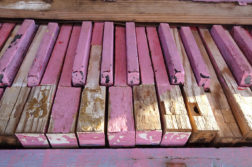The scale of the audience crisis facing Australian films became dramatically clear to me last year when I went with my partner to see a new road movie called Cactus at Sydney’s Chauvel cinema. The screening was a depressing experience. Not because of the film, which we both enjoyed. The downer was the fact that our seats were the only ones of the cinema’s 365 to be occupied.
This, please note, was not at the end of the film’s run or on a quiet, rainy night — it was on the film’s opening Sunday, with generally favourable (three and three and a half star) reviews, still fresh in the memory from the weekend’s newspapers.
We asked a staff member on the way out what the problem was and if the film had been getting more of an audience in other sessions. His reply: "You’re the first people to turn up in three sessions".
A few more people turned out to see some of the year’s other Australian films, but hardly in significant numbers. A sign of the low expectations: when commentators brayed about how great it was that the film Unfinished Sky, a well crafted drama about a lonely farmer sheltering an Afghani woman on the run from sex traffickers, had reached the $1 million box office threshold, a modest sum even for a small drama.
Overall Australian produced feature films earned $35.5 million or only 3.8 per cent of the total domestic box office in 2008, a fall from 4 per cent the previous year and below the 10-year average of 4.4 per cent. And most of that sum was taken up by earnings of a single film: Baz Luhrmann’s Australia, a US$130 million production bankrolled by Hollywood studio 20th Century Fox and the Australian tax payer, and hyped to be better than the Second Coming.
Since then things have improved — they could hardly have got worse without a total collapse. The global financial crash has seen increased cinema audiences worldwide and a more diverse slate of local films has seen a number hailed as box office successes. These include the Paul Hogan and Shane "Kenny" Jacobson comedy Charlie and Boots ($3.6 million and still going) and to everyone’s surprise, Warwick Thornton’s small-scale aboriginal drama Samson & Delilah, which earned nearly $3.17 despite taking an unflinching view of the aimless life of a petrol sniffer on the run from the law.
Last week Mao’s Last Dancer, based on the bestselling biography of Chinese expatriate ballet dancer Li Cunxin, brought the strongest news yet for the beleaguered local film industry. It had earned $3.32 million by the end of its opening weekend (once preview screenings were added). As its distributor was quick to point out, the film could also boast the fifth highest ever opening-day earnings for an Australian film — and even though that figure isn’t inflation-adjusted, it’s still an impressive result. Made for $25 million, the film needs to keep going strongly and do well in overseas markets to have a chance of earning back its production cost, but the result so far augurs well.
Now here’s the rub: Mao’s Last Dancer is no masterpiece. Though hardly a bad film by any measure, the film has struck several commentators — myself included — as somewhat lackadaisically directed by the veteran Bruce Beresford (who has delivered far stronger work in the past including Breaker Morant). For the first half the film plods on dutifully through Li Cunxin’s early life story and arrival in the US, only gaining serious traction as a drama around the mid-way point, when Li decides to defect.
The dance sequences are also curious: Chi Cao, who plays the adult Li, is a superb professional dancer who also acts perfectly adequately. Yet to compare the dance sequences — where a static camera is placed in the audience — with the elaborately photographed choreography of Michael Powell and Emeric Pressburger’s classic 1948 ballet film, The Red Shoes, is to get a sense of how great these sequences might have been.
Look at Luhrmann’s Australia and the automatic equation of strong box office with quality looks even more suspect. The problem with most Australian discussions of box office is that they’ve been focussed on how to make "better films", usually by spending more money on script development.
Time to own up: some of the best films don’t get the sizeable audiences they deserve (last year’s The Black Balloon among them), and many of those that do are mediocre or worse. Due to the policy of "front-end loading" (ie get the audience in quick), major US movies are heavily marketed to the point where they can set turnstiles spinning on opening weekend before the bad word of mouth sets in. The production of rubbish and mediocrity is no impediment to success.
We’re quick to recognise Hollywood hits don’t always equate to strong filmmaking — so why not with Australian films? Baz’s recent camp adventure may have been an artistic failure but it entertained many ordinary Australians. Why? I’d suggest any big budgeter that wallows in Australiana seems to hit an automatic chord. Look at The Man From Snowy River (critics sniffed, the public flocked). Or Crocodile Dundee I and II — the first had charm, the second was lame but that didn’t stop it earning a motzah.
Even Strictly Ballroom, which many seem to now accept as a cinematic masterpiece, is not that good a film, I’d argue — energetic and sparkly, sure, but also corny, predictable and let down by a male lead with the acting weight of a sequined cummerbund.
Hit films are not just a luxury but a necessity for any local film industry to prosper – the veteran producer Anthony Buckley likes to say that there’s nothing wrong with the local film industry that a hit film couldn’t solve. An industry that depends on public funding needs to demonstrate to the politicians and especially the taxpayers that their endeavours are appreciated by the ordinary Joe and Josephine.
This is not just a pragmatic need but I’d suggest a moral duty. No middle class art film lover — and the writer includes himself — should feel complacent about his or her passion for fine local films being kept alive by the drip-feed of tax dollars.
Wearing my critic’s hat I almost cringe at what I am about to suggest. But wearing my pragmatist’s hat I realise we need more corn, more hype, more Australiana; boatloads of escapism and showbiz; heroic journeys that end in triumph. Audiences want happiness and tears of joy and fear or films based on their favourite book of the past five years. Sometimes this means making films that I and many other critics will consider mediocre or even absolute crap. Let’s just stop being embarrassed and hypocritical about it.
Donate To New Matilda
New Matilda is a small, independent media outlet. We survive through reader contributions, and never losing a lawsuit. If you got something from this article, giving something back helps us to continue speaking truth to power. Every little bit counts.



